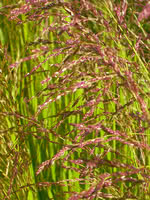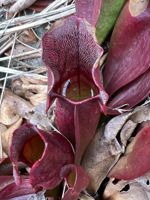Mon-Fri 9am - 5pm Mountain time
Tall Manna Grass vs Purple Pitcher Plant
Glyceria grandis
Sarracenia purpurea
CUSTOM GROW
CUSTOM GROW
Manna Grass and other waterside plants are an excellent way to prevent erosion and provide habitat and forage for animals. The difference is that Manna Grass looks better doing it! With distinctive purple grains at the top of its stalks, Manna Grass adds a splash of color to the waterside that most other aquatics can't offer.
Manna Grass is good for returning disturbed sites to nature and provides nourishment to many animals, except for cattle who find it toxic.
Purple Pitcher Plant is a native carnivorous plant, easily recognized by its purple-tinged, tubular pitchers that capture and digest insects. The nectar along the rim attracts insects to the pitcher, where slippery surfaces and downward-pointing hairs cause them to fall into the fluid below. Once inside, they are broken down, providing nutrients that allow the plant to thrive in nutrient-poor soils.
The plant produces nodding, purple-red flowers held high above the leaves. Interestingly, these blooms are pollinated by the Pitcher Plant Fly (Fletcherimyia fletcheri), whose larvae live in the fluid of the pitchers and feed on some of the trapped insects. It can be found in bogs, fens, and other wetlands. It is well-suited for wetland gardens, restoration, and naturalisation projects.
The Purple Pitcher Plant can be challenging to grow because of its specific requirements. It thrives in consistently moist (but not waterlogged), acidic soil, with a peat-and-sand mix typically recommended. The plant is sensitive to fertilizers, dissolved salts, and chlorinated water. When given the right conditions, full sun will bring out its brightest colors.
The Purple Pitcher Plant is the provincial flower of Newfoundland & Labrador.
Tall Manna Grass Quick Facts
Purple Pitcher Plant Quick Facts
Toxicity: toxic to cattle

